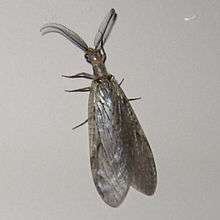Fishfly
Fishflies are members of the subfamily Chauliodinae, belonging to the megalopteran family Corydalidae.[1] They are most easily distinguished from their closest relatives, dobsonflies, by the jaws (mandibles) and antennae. In contrast to the large jaws (especially in males) of dobsonflies, fishfly mandibles are not particularly noticeable or distinctive, and the males have feathery antennae similar to many large moths. Chauliodes pectinicornis, the "summer fishfly", is a well-known species in North America.
| Fishfly | |
|---|---|
 | |
| Male fishfly (Chauliodinae ssp). | |
| Scientific classification | |
| Kingdom: | Animalia |
| Phylum: | Arthropoda |
| Class: | Insecta |
| Order: | Megaloptera |
| Family: | Corydalidae |
| Subfamily: | Chauliodinae |
| Genera | |
| |
Fishflies lay their eggs upon vegetation overhanging streams, whence the larvae, as soon as hatched, drop into the water, and go about preying upon aquatic animals. When ready to transform to pupae, they crawl out upon the bank and are then found in cavities under stones or even under the bark of trees.[2]
Fishflies are quite large, with a wingspan of 2.5 to 3 inches (6 to 8 cm). They will eat aquatic plants as well as small animals including vertebrates like minnows and tadpoles, and may live up to seven days as adults. Their entire lifespan is several years, but most of this time is spent as larvae.
Footnotes
- See references in Haaramo (2008)
- This article incorporates text from a publication now in the public domain: . New International Encyclopedia. 1905.
References
External links
| Wikispecies has information related to Chauliodinae |
- BugGuide.net
- InsectIdentification.org
- University of Kentucky
- University of Virginia
- InsectIdentification.org Fishfly photos
